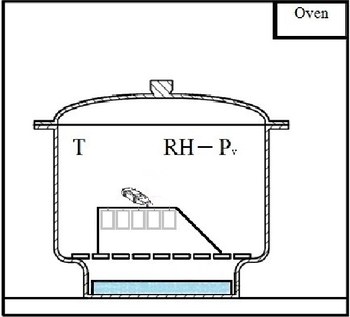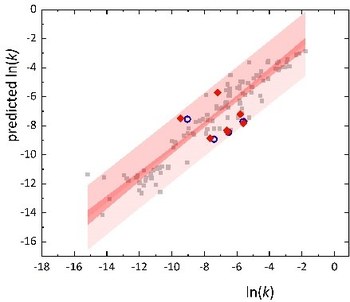Paper degradation
Degradation processes in paper-based materials inevitably occur with rates and effects which depend on a variety of factors. These factors can be associated with the paper properties (e.g., pH, lignin content) or surroundings (e.g., temperature, humidity, microorganisms). Therefore, the modern approach to study paper degradation consists in focusing not only on paper properties and storage conditions, but also on their relationship. The PhD research activity carried out by Floriana Coppola, under the supervision of Prof. Alberto Modelli, has been devoted to study paper degradation from different points of view.

In general terms, degradation of paper-based materials is mainly caused by hydrolytic, oxidative and thermal reactions, in which hydrolysis (with scission of the β-1,4-glycosidic bonds in cellulose) is usually the fastest mechanism. The well-known Ekenstam equation is largely used to describe the degradation rate as a function of the degree of polymerisation (DP):
1/DP - 1/DP0 = kt
where DP and DP0 represent the degree of polymerisation of cellulose at time t and 0, respectively, and k is the rate constant. k has an Arrhenius dependence on temperature (T), the pre-exponential factor (A) being described as a function of pH and water content [1].
There has been growing attention on the degradation of paper-based materials, likely due to the chemical destabilisation of the paper produced between 1850 and 1950. It is worth noting, however, that papermaking is currently evolving as proved by the increasing production of paper from recycled fibres. One of the aims of this research activity consists in investigating the kinetics and effects of degradation of recycled and non-recycled contemporary paper. In this regard, two kinds of contemporary paper, recycled and non-recycled were characterised in terms of acidity, fibre furnish, lignin presence, dry matter and ash content. A detailed description of the methods and results can be found in [2]. Accelerated degradation experiments were carried out exposing paper samples at various combinations of T and water vapour pressure (Pv). The samples were thus placed into closed desiccators in an oven with glycerol-water solutions at different concentrations to achieve the desired T and Pv (see left figure).

DP of the aged samples, measured by viscometric method, was evaluated to determine the degradation effects as a function of time at intervals of 4-7 days, for a total time ageing of about 40-50 days. For both the recycled and non-recycled paper, the rates of degradation were found to follow the Ekenstam equation. The degradation rates observed for the recycled paper were found to be slightly higher than the corresponding rates for the non-recycled paper, but comparable within the experimental limits. The calculated degradation rates fit fairly well a dose-response function recently modelled for historic papers [3] (see right figure). Moreover, it is worth reporting that the trend of the rate constants as a function of Pv displayed a maximum at intermediate levels. The activation energies found for both kinds of paper fall in the typical range expected for paper degradation, according to literature data.
Further analyses using samples of contemporary paper (recycled and non-recycled), artificially aged by means of oxidant solutions, are going to be carried out in order to investigate the effects and kinetics of degradation.
Destructive analyses were also employed to investigate the effects of γ-rays on chemical and physical properties of model paper. The literature reports opposed opinions on the opportunity to use γ-rays for disinfection against microorganisms, the modifications induced being not acceptable according to some authors. Model paper (pure cellulose, ash and lignin free) were irradiated at 5 and 10 kGy of γ-rays. The effects of irradiation and two additional treatments (i.e., ageing and drying) were evaluated using viscometry, mechanical tests, colourimetry, SEM and FTIR spectroscopy. Details of methods and results can be found in [4]. Larger effects on colour was found to be caused by the synergic effect of irradiation and ageing. A notable reduction in DP was found in the irradiated samples, although mechanical properties were only slightly affected by irradiation.
[1] Zou, X.; Uesaka, T.; Gurnagul, N. Prediction of paper permanence by accelerated aging I. Kinetic analysis of the aging process. Cellulose 1996, 3, 243–267.
[2] Coppola, F.; Modelli, A.; Strlič, M.; Andretta, M.; Scagnolari, F. Kinetics of degradation of non-recycled and recycled contemporary paper. Cellulose 2018, 25, 5337–5347.
[3] Strlič, M.; Grossi, C.M.; Dillon, C.; Bell, N.; Fouseki, K.; Brimblecombe, P.; Menart, E.; Ntanos, K.; Lindsay, W.; Thickett, D.; et al. Damage function for historic paper. Part III: Isochrones and demography of collections. Herit. Sci. 2015, 3, 40.
[4] Coppola, F.; Fiorillo, F.; Modelli, A.; Montanari, M.; Vandini, M. Effects of γ-ray treatment on paper. Polym. Degrad. Stab. 2018, 150, 25–30.